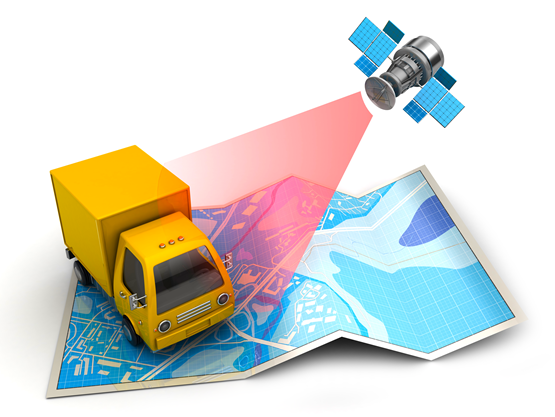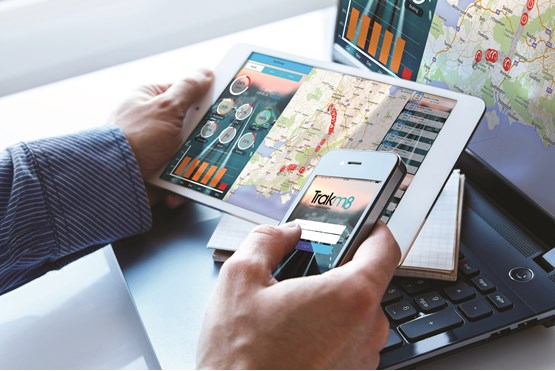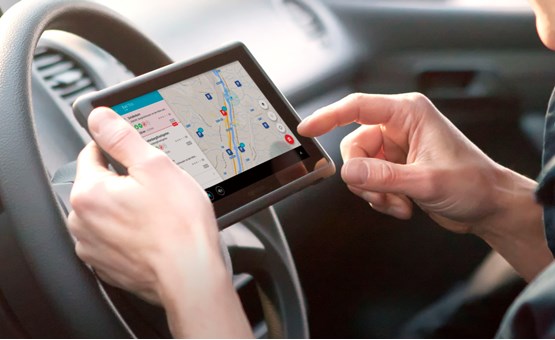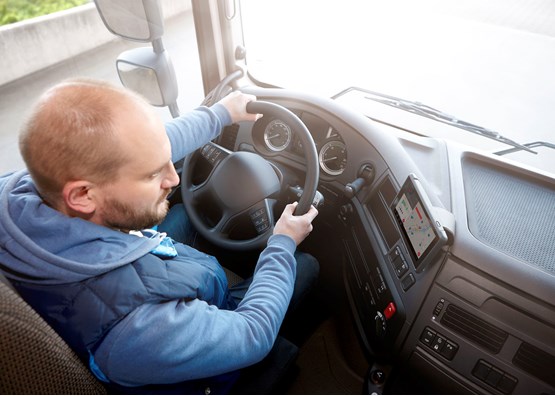Combining telematics with other systems like routing and scheduling can lead to greater efficiency and increases in productivity and profitability, John Lewis reports.
Van and truck operators are increasingly integrating their telematics packages with other systems they use to manage their fleets in a bid to improve efficiency.
For example, marrying Webfleet from TomTom Telematics to Maxoptra’s cloud-based routing and scheduling technology has helped Shoeburyness, Essex, steel stockholder Industrial Metal Services save around £250,000 in fleet costs annually.
Estimated-time-of-arrival texts generated automatically tell clients when their consignment is about to appear, resulting in fewer failed deliveries and less on-site time for drivers.
Elsewhere, integrating Webfleet with Agg Smart routing and scheduling software has helped a Leicester concrete company increase its productivity by more than 25%.

Ready-mix and concrete screed supplier Wright Mix is now able to complete up to two more jobs per vehicle per day by using what Webfleet and Agg Smart have to offer rather than its previous manual booking and scheduling system.
It has enabled a dynamic approach to scheduling to be created which can respond rapidly to the needs of customers.
They place an order, payment is pre-authorised and the job assigned to the most appropriate driver and time slot within the scheduling system.
The job details are sent to the driver’s TomTom Pro 8 terminal and navigation is automatically provided giving the driver, office and client an estimated time of arrival.
Webfleet communicates with Agg Smart throughout the whole process. This means the driver is able to check the pre-authorised payment before dropping the concrete or screed and ask the customer to sign for the delivery on-screen.
READ MORE: New commercial motor insurance underwriter Camatics combines camera and telematics technology
The exact volume of product delivered is then recorded in the Agg Smart app which allows Wright Mix’s accounting system to bill the recipient automatically and accurately; all without having to use paper or make a phone call.
“Before we had Webfleet and Agg Smart I was constantly on the phone to drivers and customers,” recalls Wright Mix operations manager Peter Harris. “The days were frantic and I used to miss lots of calls.
“Now the office is very calm and I don’t miss any.”
Trakm8 fleet strategy director Andrew Tillman agrees that integrating telematics and route scheduling is becoming increasingly important.
“You can have a mobile engineer whom you have scheduled to spend an hour fixing Mrs Smith’s washing machine only to discover that he is still there after three hours because the problem is more complex to solve than he expected,” he says.

Armed with that knowledge and aware of the status of all the other drivers you can reschedule his and their work accordingly.
Telematics data can also be used to influence routes and schedules longer-term.
It may, for example, show that your vehicles are continually arriving at a particular destination much later than you expected because traffic is running more slowly than usual down a particular section of highway.
Reason? Road works for the next six months – so they will need to be re-routed.
“About a year ago we launched a programme called Connect + with integration in mind,” says Teletrac Navman marketing director Peter Millichap.
It allows fleets to acquire a telematics system already linked to other useful packages such as Assetminder, which can manage the entire maintenance lifecycle of a fleet.
“It makes the whole exercise much easier for operators,” Millichap says. “They want solutions that are available off the shelf. Operators want to be able to plug the software together and they expect to be able to do it easily.”
Truck manufacturers, in particular, are starting to promote platforms with open-plan architecture.

The idea is to enable fleets to take the best of what different suppliers of telematics services have to offer and run them all using the same onboard box without the need for lots of different SIM cards.
Unveiled by Volkswagen Truck & Bus a year-and-a-half ago, Rio is one of the best-known examples.
An open cloud-based platform, the onboard black box it employs can be retrofitted to any make of truck – not just MANs and Scanias – with an FMS interface.
Progress in this area across the telematics industry remains slow, however, admits Tillman.
“It’s the data that matters,” he says. “The hardware should be irrelevant, but telematics companies tend to be protective of their individual boxes.”
The more systems integrate, the more all the information a business possesses is likely to be pulled together in one potentially-vulnerable location. That includes personal data held on customers and employees.
Lose such personal data after May 25 and the penalties incurred could be eye-watering.

That is when the European Union’s General Data Protection Regulation (GDPR) comes into force, imposing more stringent data protection requirements.
Voted into EU law by the European Parliament in April 2016, it supplants the Data Protection Act 1998 and will apply on this side of the Channel regardless of Brexit’s final outcome. Breach its requirements and a fine of up to €20 million (£17.5m), or up to 4% of a firm’s global turnover in the previous financial year, whichever is the greater, could await.
Conviction could also lead to separate civil litigation brought by anybody who can claim to have suffered damage because their personal data was made public.
“You should review and update your data protection policy,” advises Es Shepherd, head of member advice at the Freight Transport Association (FTA). “All too often such policies get filed and forgotten about, and when you need to look at them you require a shovel to get rid of the dust.”
As well as ensuring their own information is secure, fleets need to contact their telematics suppliers to see what measures are in place to prevent data of theirs that a supplier may hold going missing.
“Speak to their compliance officer,” advises Tillman.
READ MORE: Telematics and in-cab cameras: pushing safety standards higher
“One question a fleet might like to ask is whether the business concerned meets ISO 27001,” he adds; the international standard for the secure management of information.
Take steps to protect personal data and there is no reason why telematics systems cannot still be employed to help fleets manage their van and truck drivers.
That includes using them to monitor driving behaviour and create league tables with the aim of encouraging better performance.
With 136 vans, Scottish building services company James Frew is doing both in conjunction with Ctrack with the introduction of Ctrack Online under a five-year extension to an existing contract.
Ctrack’s DBI – Driver Behaviour Indicator – provides drivers with real-time feedback regarding speeding, harsh braking and acceleration by means of traffic light-coloured warning lights and audible alerts.
Meanwhile, a reporting tool allows the best and worst performing parts of the fleet to be identified, enabling the business to implement a targeted driver training programme.
Fuel usage has fallen sharply as a consequence and accidents, insurance premiums and maintenance expenditure are all down, too.
“By encouraging responsible driving that avoids aggressive vehicle handling, we’ve not only contributed to staff well-being but have also achieved significant operational savings and much-improved road safety,” says Sandy Clare, financial director at James Frew.
Customers often want to boil driver behaviour down to a scorecard, according to Millichap.
It can be used to identify the best and worst performers, but should also be accompanied by a rewards programme to encourage the latter to raise their game.
“Unfortunately, we’re seeing relatively few businesses implementing such programmes,” he says.
Bibby Distribution is using telematics data from Microlise to help tailor its driver training. Fuel economy has improved by 10% as a consequence, while CO2 emissions have fallen by 11%.

While the large amounts of data generated by telematics may be used to manage the fleet on a day-to-day basis, or to identify training needs, they are not always used to determine the fleet’s specification.
The Dynamon software company can analyse data in order to work out whether devices such as aerodynamic aids and fitting low-rolling-resistance tyres would reduce an operator’s fuel consumption and shrink its carbon footprint.
“The information is presented on an online dashboard for fleets, enabling them to optimise their vehicles fully,” Dynamon chief executive officer Angus Webb says.
“We can look at the cost of a particular aid, see the sort of fuel saving it might be able to achieve on the route the truck is on and assess whether it would be worthwhile.”
Also involved in the analysis of telematics data, albeit in a different way, are Driive and Matrix Telematics.
They look at it from the viewpoint of driver performance and reducing occupational road risk, arguing that many organisations with telematics systems in place do not react appropriately or consistently to the information it provides or do not know how to interpret it.
READ MORE: Top 10 KPI’s fleet managers should track, according to Mix Telematics
Telematics packages are increasingly being combined with a camera that watches the road ahead.
Harsh braking or acceleration, near misses involving a violent swerve, and collisions can be automatically recorded and uploaded to a secure server network with serious incidents triggering a text or email alert sent direct to the fleet manager.
Footage of what happened just before, during and after an incident can then be viewed remotely, often within seconds on an online dashboard.
Emergency assistance can be organised if required, vehicles can be rescheduled to avoid disruption to customers and repairs arranged.
The fleet’s insurers can also access the footage to determine any liability.
Such prompt access and the proof provided by the recording can help cut the number of claims disputes while genuine claims can be settled quickly before they escalate into something bigger. Spurious claims are more easily refuted.
What the camera has seen can also help the operator target driver training.
Downwell Group, which provides services to the construction industry including demolition, asbestos removal and the erection of scaffolding, has embraced cameras wholeheartedly.
Working with Intelligent Telematics, the Grays, Essex-based company installed forward-facing SureCam 3G cameras across its 50-plus fleet of vans and cars in early 2017.
Accident rates have dropped significantly and insurance premiums have fallen by 20%, the business reports.
“In addition to the clear insurance benefits, the cameras are having a positive impact on the behaviour of our drivers and influencing their mindset when they are on the road,” says Downwell operations director Steven Padmore.
“They also know that the emergency services can be contacted as soon as an incident has occurred and that the video can be used to validate their version of the story.”
Inward-facing cameras are also available that can be trained on the driver and triggered as an incident unfolds to see how they are reacting to it; and whether the incident has occurred because they had one eye on the road ahead and the other on their smartphone.

Introducing such cameras can lead to complaints that the employer is putting a spy in the cab and trade unions may voice opposition.
“So, go and talk to them,” advises Intelligent Telematics partnership and marketing director Sam Footer.
“Once they understand the benefits and realise the camera is not invading the driver’s privacy, they generally come round,” he contends.
They may also realise that evidence from an interior camera can be used to exonerate a union member who might otherwise be facing disciplinary action and potential prosecution for their conduct at the wheel.
Intelligent Telematics will be launching a multi-camera system that will give all-round coverage of a vehicle later this year.
Mix Telematics is among rival companies offering forward- and inward-facing cameras and can install externally-mounted ones which can monitor activity all around a truck.
If the forward- and inward-facing cameras are triggered, then the footage is displayed within the Mix Fleet Manager platform which shows it overlaid with journey and vehicle data such as speed and revs.
In-cab cameras can be put to uses other than monitoring the conduct of a driver once triggered, says Tillman.
“We’ve had one operator who asked for a camera to be mounted on the inside of the A pillar on the passenger side of each of his vehicles and pointing across the cab,” he says.
Because of the nature of his operation he was getting members of the public banging on drivers’ doors and shouting abuse at them. He wanted those incidents recorded to help protect his employees.

















Login to comment
Comments
No comments have been made yet.